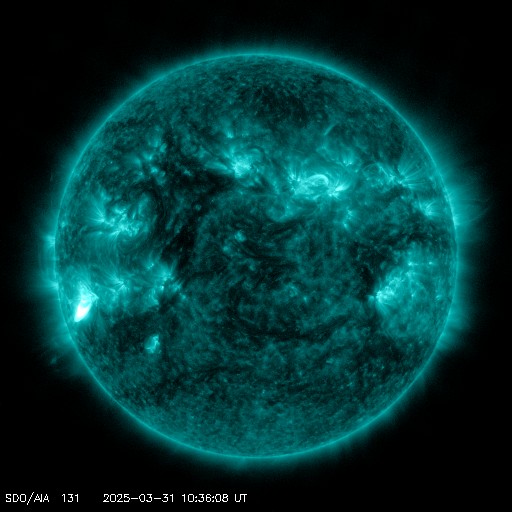Viewing archive of Wednesday, 20 March 2002
Solar activity report
Any mentioned solar flare in this report has a scaling factor applied by the Space Weather Prediction Center (SWPC). Because of the SWPC scaling factor, solar flares are reported as 42% smaller than for the science quality data. The scaling factor has been removed from our archived solar flare data to reflect the true physical units.
Report of Solar-Geophysical Activity 2002 Mar 20 2200 UTCPrepared by the NOAA © SWPC and processed by SpaceWeatherLive.com
Joint USAF/NOAA Report of Solar and Geophysical Activity
SDF Number 079 Issued at 2200Z on 20 Mar 2002IA. Analysis of Solar Active Regions and Activity from 19-2100Z to 20-2100Z
Solar activity was low. A long-duration C4 flare began
at 1544 UTC and lasted until 1919 UTC. The corresponding source on
the disk was not entirely certain but it seemed most likely to be
correlated to activity observed in Region 9866 (S08W73). Additional
C-class subflares occurred during the day, with many of these coming
from Region 9875. Region 9875 showed steady growth during the past
24 hours. Three new region were assigned today: 9876 (S16E65), 9877
(N18W29), and 9878 (N08E75).
IB. Solar Activity Forecast
Solar activity is expected to be low
to moderate during the next three days.
IIA. Geophysical Activity Summary 19-2100Z to 20-2100Z
The geomagnetic field was quiet until 1329 UTC when a sudden impulse
(SI) occurred. Since then the geomagnetic field has ranged from
quiet to active levels. The SI was caused by an interplanetary shock
which was seen at the ACE spacecraft at 1307 UTC. The disturbance is
most likely the result of the halo CME was observed in LASCO C2 at
18/0254 UTC. The shock also pushed the greater than 10 MeV proton
fluxes up to about 19 PFU at 1525 UTC. The proton event fluxes
dropped below event level at 1820 UTC.
IIB. Geophysical Activity Forecast
The geomagnetic field is
expected to be mostly unsettled for the next three days. There is a
chance for some isolated active levels on the second day as a
possible response to yesterday's partial halo CME.
III. Event Probabilities 21 Mar to 23 Mar
| Class M | 50% | 50% | 50% |
| Class X | 05% | 05% | 05% |
| Proton | 10% | 10% | 05% |
| PCAF | yellow | ||
IV. Penticton 10.7 cm Flux
Observed 20 Mar 188 Predicted 21 Mar-23 Mar 175/170/165 90 Day Mean 20 Mar 213
V. Geomagnetic A Indices
Observed Afr/Ap 19 Mar 015/017 Estimated Afr/Ap 20 Mar 010/010 Predicted Afr/Ap 21 Mar-23 Mar 010/010-015/015-010/008
VI. Geomagnetic Activity Probabilities 21 Mar to 23 Mar
| A. Middle Latitudes | |||
|---|---|---|---|
| Active | 25% | 35% | 25% |
| Minor storm | 20% | 25% | 20% |
| Major-severe storm | 10% | 15% | 10% |
| B. High Latitudes | |||
|---|---|---|---|
| Active | 25% | 35% | 25% |
| Minor storm | 20% | 25% | 20% |
| Major-severe storm | 10% | 15% | 10% |
All times in UTC
Current data suggests there is a slight possibility for aurora to appear at the following high latitude regions in the near future
Gillam, MB, Yellowknife, NTLatest news
Latest forum messages
AR4048 57Similar AR 3664 vs AR 4048 ??? 6Temporary Topic - Ongoing Solar Proton Events 5Unspecified geomagnetic activity 2176NOAA space weather enthusiasts darhboard 4
More topicsSupport SpaceWeatherLive.com!
A lot of people come to SpaceWeatherLive to follow the Sun's activity or if there is aurora to be seen, but with more traffic comes higher server costs. Consider a donation if you enjoy SpaceWeatherLive so we can keep the website online!

Latest alerts
06:48 UTC - Radio Blackout
Moderate R2 radio blackout in progress (≥M5 - current: M5.36)
06:45 UTC - Radio Blackout
Minor R1 radio blackout in progress (≥M1 - current: M1.7)
02:15 UTC - Solar protons
Moderate S2 Solar Radiation Storm - Infrequent effects on HF radio through polar regions and satellite operations
Monday, 31 March 2025
11:15 UTC - Solar protons
Minor S1 Solar Radiation Storm - Minor impacts on HF radio through polar regions
10:45 UTC - Solar flare
Moderate M1.26 flare
Space weather facts
| Last X-flare | 2025/03/28 | X1.1 |
| Last M-flare | 2025/03/31 | M1.2 |
| Last geomagnetic storm | 2025/03/27 | Kp5 (G1) |
| Spotless days | |
|---|---|
| Last spotless day | 2022/06/08 |
| Monthly mean Sunspot Number | |
|---|---|
| February 2025 | 154.6 +17.6 |
| Last 30 days | 128.5 -22.7 |



